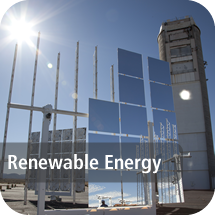Energy Security
The Energy Security program area works to reduce the risks of transformative energy solutions that will enhance the nation’s security and economic prosperity. Energy security research at Sandia seeks to address key challenges facing our nation and the world. We work with the energy industry to improve current hardware and develop the next generation of technologies to extract or produce energy.
The Energy, Climate, and Infrastructure Security (ECIS) Strategic Management Unit (SMU) spearheads research into energy alternatives that will help the nation reduce its dependence on oil and coal and to combat the effects of climate change. Sandia’s long history with geothermal, solar, and wind energy research has seen a vast increase in effort and intensity over the past 15 years and has also been supplemented in recent years with efforts in biologically based fuels: biomass from nonfood plant sources and algae—both of which can be grown on land unsuitable for farming.
 Renewable energy is energy which comes from natural resources such as sunlight, wind, rain, tides and waves, and geothermal heat, which are naturally replenished.
Renewable energy is energy which comes from natural resources such as sunlight, wind, rain, tides and waves, and geothermal heat, which are naturally replenished.
 Transportation Energy programs at Sandia share a common goal: reducing dependence on petroleum-based fuels and developing sustainable alternative fuels and increased efficiency of vehicle technologies.
Transportation Energy programs at Sandia share a common goal: reducing dependence on petroleum-based fuels and developing sustainable alternative fuels and increased efficiency of vehicle technologies.
No single technology solution will address the hurdles in front of us; the future calls for a variety of options available to consumers. To that end, we have a broad portfolio of research activities related to achieving our transportation energy mission:
 Sandia National Laboratories’ Nuclear Energy and Fuel Cycle Programs provide a dynamic, multifaceted approach to systems-based research and development of nuclear energy and fuel cycle technologies. Sandia supports the safe, secure, reliable, and sustainable use of nuclear power worldwide through strengths in repository science, nonproliferation, safety and security, transportation, modeling, and system demonstrations. As a national leader, Sandia strives to enhance the nation’s security and prosperity through sustainable, transformative approaches to the world’s most difficult nuclear energy challenges.
Sandia National Laboratories’ Nuclear Energy and Fuel Cycle Programs provide a dynamic, multifaceted approach to systems-based research and development of nuclear energy and fuel cycle technologies. Sandia supports the safe, secure, reliable, and sustainable use of nuclear power worldwide through strengths in repository science, nonproliferation, safety and security, transportation, modeling, and system demonstrations. As a national leader, Sandia strives to enhance the nation’s security and prosperity through sustainable, transformative approaches to the world’s most difficult nuclear energy challenges.
Since the late 1970s, this program has developed and transferred Sandia technologies to assist the natural gas and oil industry, especially U.S. independent producers. Our goal is to maintain a secure, economic supply of the nation’s natural gas and crude oil.
 The novel approaches to increasing energy efficiency and developing clean energy sources developed in the national laboratories can then be transferred to industry to resolve the nation’s energy future.
The novel approaches to increasing energy efficiency and developing clean energy sources developed in the national laboratories can then be transferred to industry to resolve the nation’s energy future.
 ECIS Highlights
ECIS Highlights













 RSS
RSS Google+
Google+ Twitter
Twitter Facebook
Facebook LinkedIn
LinkedIn YouTube
YouTube Flickr
Flickr









